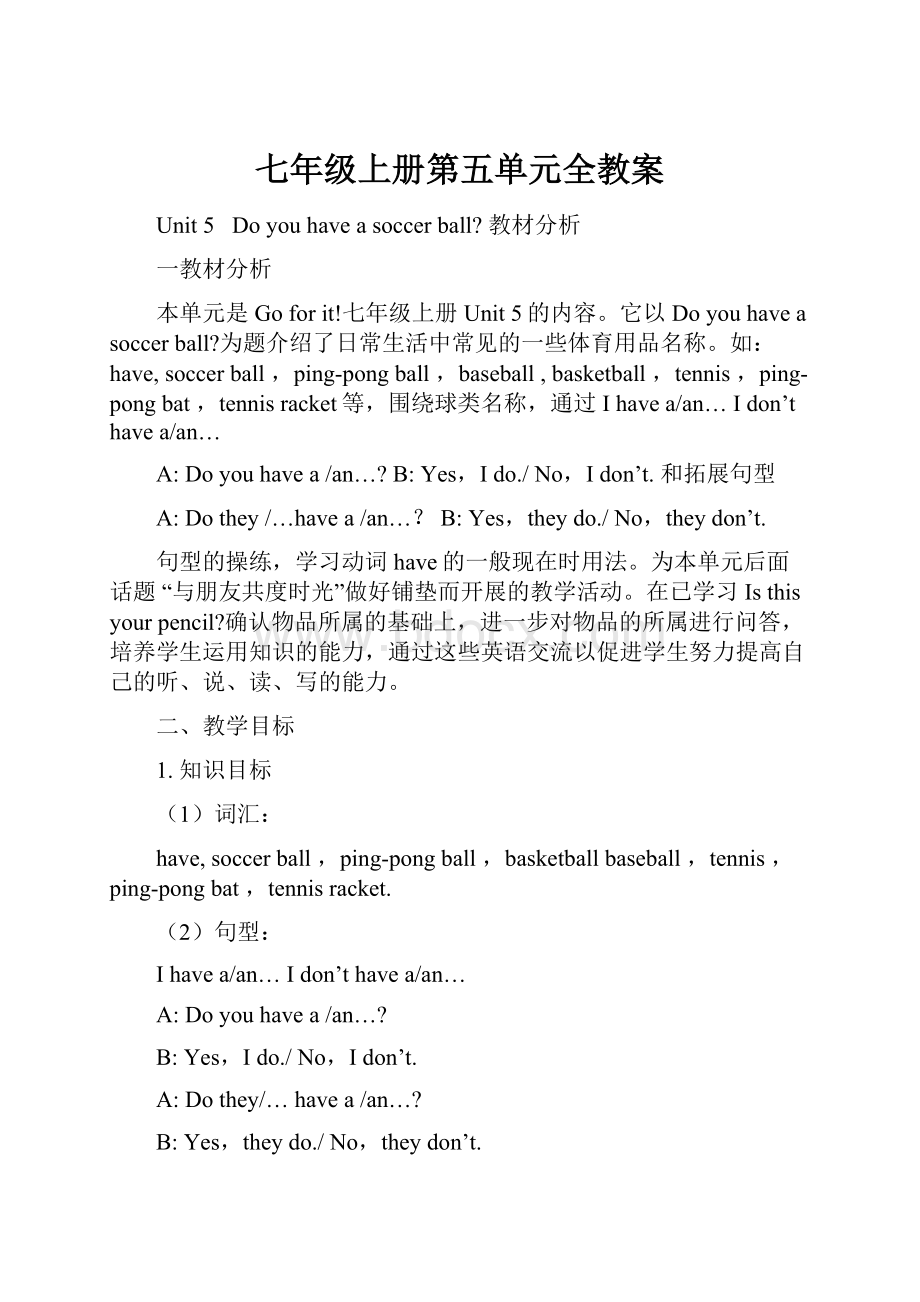七年级上册第五单元全教案.docx
《七年级上册第五单元全教案.docx》由会员分享,可在线阅读,更多相关《七年级上册第五单元全教案.docx(41页珍藏版)》请在冰豆网上搜索。

七年级上册第五单元全教案
Unit 5 Do you have a soccer ball?
教材分析
一教材分析
本单元是Goforit!
七年级上册Unit5的内容。
它以Doyouhaveasoccerball?
为题介绍了日常生活中常见的一些体育用品名称。
如:
have,soccerball,ping-pongball,baseball,basketball,tennis,ping-pongbat,tennisracket等,围绕球类名称,通过Ihavea/an…Idon’thavea/an…
A:
Doyouhavea/an…?
B:
Yes,Ido./No,Idon’t.和拓展句型
A:
Dothey/…havea/an…?
B:
Yes,theydo./No,theydon’t.
句型的操练,学习动词have的一般现在时用法。
为本单元后面话题“与朋友共度时光”做好铺垫而开展的教学活动。
在已学习Isthisyourpencil?
确认物品所属的基础上,进一步对物品的所属进行问答,培养学生运用知识的能力,通过这些英语交流以促进学生努力提高自己的听、说、读、写的能力。
二、教学目标
1.知识目标
(1)词汇:
have,soccerball,ping-pongball,basketballbaseball,tennis,ping-pongbat,tennisracket.
(2)句型:
Ihavea/an…Idon’thavea/an…
A:
Doyouhavea/an…?
B:
Yes,Ido./No,Idon’t.
A:
Dothey/…havea/an…?
B:
Yes,theydo./No,theydon’t.
2.能力目标:
(1)掌握所给的有关体育词汇,运用所属关系句型:
Doyouhaveasoccerball?
进行问答,并能把它们运用到生活中去。
培养学生良好的听、说、读、写的能力。
(2)通过观察、想象、模仿和表演等能熟练、生动地模拟操练、运用句型,并具有一定的独创性。
3.情感目标:
(1)通过球类运动词汇的学习与运用,让学生体会到一种学习的成功感。
可以提高他们学习英语的兴趣,积极参与英语实践活动。
(2)在与同伴合作完成任务中,体验一种集体荣誉感,增强团队精神。
(3)热爱学习,热爱运动。
三、教学重点难点
教学重点:
1.词汇:
have,soccerball,ping-pongball,basketballbaseball,tennis,ping-pongbat,tennisracket.
2.句型:
Ihavea/an…Idon’thavea/an…
A:
Doyouhavea/an…?
B:
Yes,Ido./No,Idon’t.
A:
Dothey/…havea/an…?
B:
Yes,theydo./No,theydon’t.
教学难点:
1.运用助动词do。
2.除you外,其他人称使用have的用法。
四、课时安排
SectionA1a—1c1课时
SectionA2a—2d1课时
SectionA3a-3c1课时
SectionB1a—1d1课时
SectionB2a—2c1课时
SectionB3a—Self-check1课时
Unit 5 Do you have a soccer ball?
知识要点归纳
1.Doyouhave......?
Yes,Ido.No,Idon’t..
你有……吗?
是的,我有。
不,我没有。
Dotheyhave......?
Yes,theydo.No,theydon’t..
Doeshehave......?
Yes,hedoes.No,hedoesn’t.
Doesshehave......?
Yes,shedoes.No,shedoesn’t.
在一般现在时中,句子的谓语动词若是实义动词,常借助助动词do或does来构成否定句或疑问句。
Does用于主语是第三人称单数的句子中,其他情况用do。
2.do/does
1)作助动词,帮助构成一般现在时的否定句或疑问句,无意义。
Doyouhaveasoccerball?
你有足球吗?
Idon’tknow.我不知道。
DoesJimhaveasister?
吉姆有妹妹吗?
Whatdoeshelike?
他喜欢什么?
Hedoesn’tlikeEnglish.他不喜欢英语。
2)作实义动词,“做,干”。
Idomyhomeworkeveryday.我每天都做家庭作业。
Bobdoeshishomeworkeveryday.鲍勃每天都做家庭作业。
3)在一般现在时中,do/does可用来替代上文出现过的动词,以避免重复。
Doyouhaveasoccerball?
你有足球吗?
Yes,Ido.是的,我有。
(do代have)
Doesshehaveaneraser?
Yes,shedoes.
Idon’thaveasoccerball,butmybrotherAland
oes.
我没有足球,但我的哥哥艾伦有。
3.Let’sdosth.“(让)我们做某事吧。
”表示建议。
(let’s=letus)
肯定回答一般用Thatsoundsgood.(那听起来很好)/OK.好的/Allright.好的/Great.好极了/Goodidea.好主意
否定回答一般用sorry,I...
1)让我们上学去吧
。
好的。
2)我们打乒乓球吧。
对不起,我有许多家庭作业要做。
4.letsb.dosth.让某人作某事
1)让他踢足球。
2)让海伦回家吧
5.We’relate!
我们迟到了!
belatefor….……
迟到Don’tbelateforschool.不要上学迟到。
6.play+球类名词:
打/踢……球(注意:
球类运动不用冠词)
playping-pong/basketball/volleyball/tennis/soccer
7.sound
1)连系动词,“听起来”,后接形容词作表语。
Thatstorysoundsveryinteresting.那故事听起来很有趣。
2)名词“声音”(泛指自然界中的各种声音)。
Thesoundistooloud.声音太大了。
8.Weplayitatschoolwithourfriends.我们和我们的朋友在学校踢。
1)atschool在学校
2)with“和;与;跟……在一起”
9.It’seasyforme.这对我来说挺容易的。
10.sportsclub体育俱乐部
Sport“运动”,修饰名词时,总是用复数形式。
sportsmeeting运动会sportsshoes运动鞋
11.play/dosports做运动
12.watchTV看电视
13.onTV/ontheradio/onthecomputer/onthephone在电视上/在收音机上/在电脑上/在电上电子产品上用介词on。
14.everyday每天Sheplayssportseveryday.她每天都做运动。
everyday日常的everydayEnglish日常英语
15.afterclass下课后afterschool放学后
16.辨析interesting与interested
1)interesting可作表语,指某人/事/物本身有趣;也可作定语修饰人或物
①Thebookisinteresting.这书很有趣。
(作表语)
②Ihaveaninterestingbook.我有本有趣的书。
(作定语)
2)interested用于be/get/becomeinterestedin…(对……感兴趣)这一结构中。
Heisinterestedinplayingfootball.他对踢足球感兴趣。
17.时态概说
在英语中,不同时间发生的动作或存在的状态,要用不同的动词形式来表示,这种表示动作发生时间的各种动词形式称
为时态。
Iam14thisyear.今年我14
岁。
Iwas13lastyear.去年我13岁。
Heplayssoccerevery
day.他每天都踢足球。
Heplayedsocceryesterday.昨天他踢足球了
18.一般现在时
一般现在时表示现在的状态,如:
Heis12.Sheisathome.表示经常的或习惯性的动作,如:
Igotoschoolat7:
30everyday.表示主语具备的性格和能力等,如:
Shelikesapples.TheyknowEnglish.
1)动词be
肯定式
否定式
Iam....
Youare....
He/She/Itis....
We/You/Theyare....
Iamnot....
Youarenot....
He/She/Itisnot....
We/You/Theyarenot....
疑问式和简略答语
AmI....
?
Yes,youare.
No,youarenot.
Arewe....?
Yes,we/youare.
No,we/youarenot
Areyou....?
Yes,Iam.
No,Iamnot.
Areyou....?
Yes,weare.
No,wearenot.
Ishe/she/it....?
Yes,he/she/itis.
No,he/she/itisnot.
Arethey....?
Yes,theyare.
No,theyarenot.
2)动词do
肯定式
否定式
Ilike....
Youlike....
He/She/Itlikes....
We/You/Theylike....
Idonot(don’t)like....
Youdonot(don’t)like....
He/She/Itdoesnot(doesn’t)likes....
We/You/Theydonot(don’t)like....
疑问式和简略答语
DoIlikeoranges?
Yes,youdo.
No,youdonot(don’t)
Dowelikeoranges?
Yes,we/youdo.
No,we/youdonot(don’t)
Doyoulikeoranges?
Yes,Ido.
No,Idonot(don’t)
D
oyoulikeoranges?
Yes,wedo.
No,wedonot(don’t)
Doeshe/she/itlikeoranges?
Yes,he/she/itdoes.
No,he/she/itdoesnot.
Dotheylikeoranges?
Yes,theydo.
No,theydonot(don’t)
当主语是第三人称单数时,动词形式有以下几种变化:
规则
动词原形
第三人称单数形式
一般动词在词尾加-s,在清辅音后读/s/,在
浊辅音或元音后读/z/,在t后
读/ts/,在d
后读/ds/。
help
like
swim
listen
know
play
get
find
helps/helps/
likes/laiks/
swims/wimz/
listens/’lisənz/
knows/nəʊz/
plays/pleiz/
gets/gets/
finds/faindz/
以字母s,x,sh,ch结尾的动词加-es,读/iz/。
如果动词原形词尾已有e,则加s。
以o结尾的动词也加-es,读/z/。
teach
go
teaches
goes
以辅音字母加y结尾的动词,先边y为i,
再加-es,读/z/。
study
studies
2015-2016学年度七年级123班英语教案
Title
Unit 5 Do you have a soccer ball?
Thetype
Oflessons
Newlesson
Numberofsections
Designer
张斌年
Auditor
赵世鹏
Teacher
Date
AnalysisoftheTeachingMaterial
【Curriculumrequirements】
thecoursemainlyintroducetheballwordsandsentencesDoyouhave.....?
Sointheexplanationpatternsbefore,letstudentcognitivewords,canusepicturesandphysicalmethodsforinstruction.
AnalysisoftheTeachingMaterial:
thecoursemainlyintroducetheballwordsandsentencesDoyouhave.....?
Sointheexplanationpatternsbefore,letstudentcognitivewords,canusepicturesandphysicalmethodsforinstruction.
TeachingAimsandDemands
KnowledgeObjects:
—Doyouhaveaping–pongball?
—Yes,Ido./No,Idon’t.
have,ball,tennis,ping–pong,volleyball,basketball,let,us,play,well,sound,sport,we,many,club,more,class,interesting,boring,fun,difficult,watch,has,great,but,only,them,every,day
AbilityObjects:
Enablethestudentstounderstandandtalkaboutownershipandmakesuggestions.
MoralObjects:
Enablethestudentstoformpositiveattitudetowardsportscollectionandlovesports,keephealthyandlearntomakesuggestionspolitely.
TeachingKeyPoints
AndTeachingDifficultPoints
TeachingKeyPoints
Talkaboutownershipandmakesuggestions.
TeachingDifficultPoints
—Doyouhaveaping–pongball?
—Yes,Ido./No,Idon’t.
Teachingaid
Textbookrecorder
Designofperiod
Period1
TeachingProcedures
Teacher-studentInteraction
Revise
Step1.RevisionandLead-in
Askoneormorestudentstoshowtheirhomework.
WangWeitennis
LiHongping–pong
YangQuansoccerball
QuZhiivolleyball
LiuFangbasketball
Firstpointtoastudentinthechartwhohastennis.
T:
Doyouhavetennis?
S:
Yes,Ido.
Secondpointtotheothersintheclassroom.
T:
DoesWangWeihavetennis?
S:
Yes,hedoes.
ThirdpointtoLiHongintheclassroomwhohasping–pongball,butnotennis.
T:
Doyouhavetennis?
S:
No,Idon’t.
T:
Doyouhaveaping–pongball?
S:
Yes,Ido.
T:
DoesLiHonghavetennis?
Ss:
No,shedoesn’t.
T:
DoesLiHonghaveaping–pongball?
Ss:
Yes,shedoes.
T:
Todaywearegoingtolearnhowtotalkaboutownershipandmakesuggestions.
Step2.ListingandSpeaking
T:
Whatcanyouseeinthepicture?
Ss:
Wecanseeaping–pongball,aping–pongbat,atennisracket,asoccerball,volleyball,abasketball,aTV,acomputergame.
T:
Askthestudentstomatchthewordswiththethingsinthepicture.
Ss:
Say,Number1is(C),tennisracket.Number2is(a),ping–pongball…
Step3.Pairwork
Askformoreideasfromthestudentsandwritetheirideasontheblackboard.
phone,cars,pencilcase,eraser,pen,book,dictionary,watch,key,notebook,ring,sister,brother,chair,bookcase,CD,videotape,hat,desk,dresser…
Showthefollowingtothestudentsandthenaskthemtopracticeinpairs.
—Doyouhaveaphone?
—Yes,Ido.
—DoyouhaveaCD?
—No,Idon’t.
T:
Nowworkinpairs,makeconversationswiththenewwordsin1aandactitoutaroundthestudents.
Sampleconversations:
1.S1:
Doyouhaveaping–pongbat?
S2:
Yes,Ido.
S1:
Doyouhaveaping–pongbat?
S2:
No,Idon’t.
2.S3:
Doyouhavevolleyball?
S4:
Yes,Ido.
S3:
Doyouhaveabasketball?
S4:
No,Idon’t.
3.S5:
Doyouhaveatennisracket?
S6:
Yes,Ido.
S5:
DoyouhaveaTV?
S6:
No,Idon’t.
StepⅣSummary
Pleaseaskyourclassmatesinthegroupwhatballshe/shehas.Thenwritedowntheinformationinthechart.Nowwhowantstodisplayyourprojectontheblackboard?
AskthestudentstoreadthepictureonPage25.
Askformoreideasfromthestudentsandwritetheirideasontheblackboard.
BlackboardDesign
—Doyouhaveaping–pongball?
—Yes,Ido./No,Idon’t.
Homework
1.Askthestudentstodomorepracticeasrequiredin1conPage25.
2.Askthestudentstopreparethenextperiod.Thinkabouttheusageof“Doesshe/hehave…?
”
Recordafterteaching
2015-2016学年度七年级123班英语教案
Title
Unit 5 Do you have a soccer ball?
Thetype
Oflessons
Newlesson
Numberofsections
Designer
张斌年
Auditor
赵世鹏
Teacher
Date
AnalysisoftheTeachingMaterial
【Curriculumrequirements】
thecoursemainlyintr